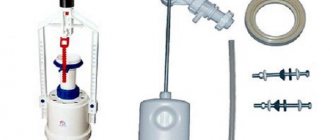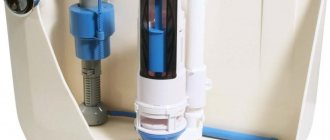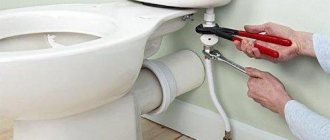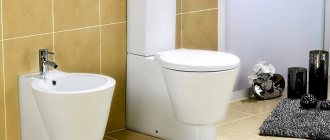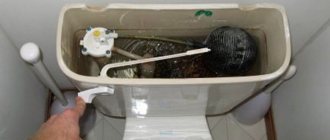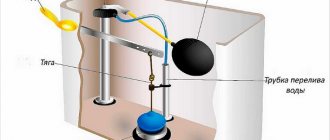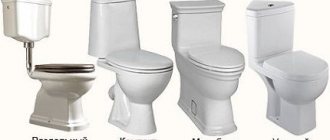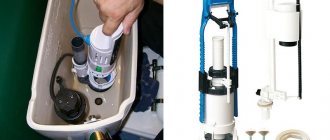The quality of the toilet directly depends on the serviceability of the shut-off valves responsible for the supply and drainage of water. Currently, you can see many different models of this plumbing equipment on sale. There are not many types of shut-off valves, since they are of the same type and are suitable for various modifications. Let's take a closer look at how toilet shut-off valves work.
- 2 Upper and lower shut-off valves for the toilet
- 3 Operation of the toilet cistern flush mechanism
- 4 The process of installing toilet shut-off valves
- 5 Malfunctions in the operation of the drain tank
- 6 Video instructions for installing toilet fittings
Types of installation of waste cisterns
There are three types of toilet cistern installation:
Type 1 - a cistern suspended high above the toilet. This type is familiar to almost every resident of our country. Not too pretentious in appearance, it nevertheless has undeniable advantages:
- simplicity of design (which makes it easy to repair it yourself);
- the high speed with which the flow of water rushes from a height into the toilet bowl.
Type 2 - a flush cistern installed on the toilet shelf. Most modern apartments and public institutions use this type of device.
Type 3 – tank built into the wall. It looks more like a thick-walled polyethylene canister.
All manipulations to replace the fittings of such a tank are carried out through the hole in the drain button .
In order to successfully install a toilet or bidet, you need to know what the slope of the sewer pipe should be, this is necessary so that the pipes do not become clogged and wear out prematurely. The most important and up-to-date information.
If the toilet “does not leak”, then the water consumption is minimal. However, in addition to paying for water, it is necessary to regularly check water meters. Read about the cost, conditions and frequency of this procedure right here, there are many useful tips on how to save on checking meters!
Adjustment and configuration of drain fittings
The lower fittings are adjusted by rotating the adjusting screw. It sets the position of the float relative to the thrust. To fill the container as much as possible, turn the screw counterclockwise. If minimal filling is required, adjust clockwise.
By moving the float chamber along the rod, the liquid level in the tank is adjusted. When the lever has an increased size, the level can be increased and vice versa. To do this, simply unscrew the fixing screw, install it in the desired position and lock it.
The float can be moved along a toothed plastic rod. The water level in models with a metal rod can be changed by bending the rod in the desired direction.
Having mastered the principle of constructing a drain tank, you can deal with all the problems on your own. Even if the breakdown is repaired by a plumber, you can evaluate and accept his work. When deciding which fittings to choose, you should remember that top-connected mechanisms are cheaper, simpler, and bottom connections can also be reliable if all installation rules are followed.
Drain mechanism
It is unlikely that we should consider installing drain fittings for suspended structures in our time: they have long lost their relevance.
Therefore, in the future we will only talk about shut-off valves of the most common types - cisterns installed directly on toilets.
According to the method of activating the drain device, the mechanisms are divided into two groups:
- exhaust (rod).
In order to activate the device of this group, you need to use the handle to lift the top of the rod that locks the drain hole. In modern models of tanks, such a mechanism is practically never found. It is preserved only in fairly old models; - push-button (push-button). The mechanisms of this group are divided, in turn, into two subgroups:
- with single-mode flush: this type of mechanism is equipped with one button (key), when pressed, the entire contents of the tank are flushed into the toilet;
- with dual-mode flush: the button-key in this design consists of two parts. Using one half you can reset only half the volume of the tank, using the second - the full volume.
There is another type of tank: devices equipped with a stop function.
[wpmfc_short code="Block2"]
What are the drainage mechanisms?
All you need to do to flush the toilet after visiting the toilet is to press the button on the tank. Then the entire mechanism works independently: the water drain valve opens via the drain valve. After this, the contents of the tank flow into the bowl, washing away all feces and sewage with its flow.
The toilet flush mechanism can be activated in several ways:
- By pressing a button.
- Focus on the lever.
- We pull the chain.
The configuration and design of the cistern varies. Typical containers have a standard volume of 6 and 4 liters, equipped with holes for water inlet of standard diameters. Siphon mechanisms for toilet cisterns are available in several varieties. They are installed quite simply, so if the indoor unit breaks down, it can be replaced without any problems.
Types of float valves
There are several types of float valves.
- Croydon valve. It consists of a body, a float lever axis, a piston and a seat.
The float lever drives the piston. The piston movement in Croydon valves is vertical. This design is installed in old-style tanks. - Piston valve. In this design, the axis of the float lever is secured in a cotter pin, split in two.
By moving, the lever forces the piston to move in a horizontal direction. The piston, periodically in contact with the seat, regulates the flow of water into the tank.A gasket is mounted at the end of the piston, which blocks the water flow when the piston presses on the seat. Tanks with piston valves are found in many Russian apartments.
- Diaphragm valve .
In this type of design, a membrane (rubber or silicone) is installed instead of a piston gasket. The plastic piston, moving under the action of the lever, also moves the membrane. It blocks the water inlet. The diaphragm valve is the latest advancement in the production of cisterns.
In addition to plumbing, water can be used for additional heating of rooms. Recently, warm water floors have been gaining popularity, creating an optimal microclimate in the apartment. To learn how this can be organized, read the article Installing a water-heated floor. It’s not such an expensive pleasure, but the benefits of keeping your feet constantly warm are undeniable!
Summer water outages are not a problem if you have a water heater. One of the most popular companies in Russia is the Termex company, read about its water heaters with a capacity of 80 liters or more here, let your home always be comfortable.
Main types of shut-off valves for toilets and prices
The design of shut-off valves can be combined or separate, and the first option appeared relatively recently. Separate configuration fixtures require that the toilet flush and shutoff valve be installed separately. Each of these elements operates autonomously, independently of each other.
The shut-off valve is controlled by a float. When the water level in the tank rises, this element blocks the flow of liquid. The main component of the drain assembly is the neck, which is equipped with a mechanical or air valve. The drain is controlled by pressing a pedal, lever, button or key.
Fittings with a separate configuration have one significant advantage. If one of the components fails, it is not necessary to completely replace the insides of the toilet cistern - it is enough to repair or update the damaged area. This design not only simplifies the process of installing and dismantling parts, but also reduces the cost of repairing damage.
Toilet fittings can be for side or bottom water supply
In the latest models of toilets, as well as luxury-class plumbing fixtures, combined fittings are installed, in which the shut-off and drain valves are combined into one design. These components are completely dependent on each other. If the combined valves fail, it will not be possible to replace one of the valves. In the event of a breakdown, you will have to completely dismantle the system and carry out complex repair work.
Important! Installation of the mechanism with the top connection is carried out after the tank is installed in its place. The arrangement of fittings with a lower type of fastening begins before placing the tank.
Buying toilet fittings: prices for products from different manufacturers:
| product name | price, rub. |
| Fittings for toilets "Inkoer" | |
| Side diaphragm valve, 1/2 | 300 |
| Side float valve, 1/2 | 500 |
| Side float valve "lux", 1/2 | 800 |
| Fittings for toilets "Alkaplast" | |
| Side valve | 450 |
| Bottom valve | 520 |
| Metal threaded side valve | 550 |
| Bottom valve with metal thread | 610 |
| Geberit toilet fittings | |
| Bottom valve, 3/8 (hole size 16 mm) | 1150 |
| Bottom valve 3/8 (hole size 20mm) | 1180 |
| Bottom valve 1/2 (hole size 20mm) | 1200 |
| Siamp toilet fittings | |
| Side valve 1/2 | 1600 |
| Side valve 3/8 | 1800 |
Characteristics of shut-off valves for a toilet with bottom supply
Bottom-mounted fittings are usually installed in foreign-made toilets. These designs do not create much noise, and therefore they increase the operating comfort of the plumbing fixture. Toilets that have a system with a bottom connection look more stylish than models where the water supply is from above.
The bottom line system consists of the following components:
- a float that regulates the process of supplying liquid to the tank;
- trigger device;
- guide (the float moves along it);
- sealing rings (used to seal the structure during the installation of fittings);
- intake valve.
Foreign-made toilets are equipped with fittings with a bottom type of connection
The principle of operation of shut-off valves for a toilet with a bottom connection is quite simple. This system maintains the required fluid level in the tank. When the container is full, the valve closes the tap and stops the water supply, and after draining, it opens it again.
Related article:
Toilet flush mechanism: operating principle and basics of device repair
Types of internal fittings of the tank. Dismantling, installation and adjustment of the mechanism. Troubleshooting.
There are two types of filler units:
- Push-button – liquid drains automatically when you press the button.
- Rod - water is drained in the same mode, but pressing the button alone will not be enough. In this case, the design provides for the presence of a handle, which must first be pulled up and then returned to its original place.
The push-button option is considered more practical, so it is used more often by manufacturers.
Advantages of shut-off valves for the toilet cistern:
- high degree of reliability;
- there is rarely a need for repairs;
- allows you to hide the inlet hose;
- works silently;
- long service life.
Bottom line fittings consist of a float, release device, guide, O-rings and inlet valve
This version of the fittings is not without its drawbacks. Installation of the system is very complicated. If a breakdown occurs, it is easier to replace the drain tank fittings than to repair its individual parts.
Note! For the push-button mechanism to work properly, the release button should not protrude above the surface of the structure. The optimal opening size is 40 mm. This value is applicable for round mechanisms. Some toilet models have rectangular or oval buttons.
Characteristics of shut-off valves for a cistern with side connections
In domestically produced plumbing fixtures, a system with a top (side) connection is mainly installed. In this case, the supply hose is not attached to the bottom of the container, but to the side, and it should be located above the liquid level in the filled tank.
The main components of the fittings for a toilet cistern with side supply:
- inlet valve supplying water;
- float (connected to the inlet valve using a lever);
- trigger mechanism;
- a lever designed to control the trigger mechanism.
Domestic toilets are made with side connections
The release mechanism of side-mounted fittings can be push-button or rod-type.
Operating principle of toilet fittings with side connections:
- After pressing the button, a draft is generated that opens the drain valve.
- When draining occurs, the fluid supply to the drain mechanism is shut off.
- When the water in the tank reaches the minimum limit, the release mechanism is activated, which closes the drain.
- Then the float hole opens.
- The vertically located valve returns to its place and closes the passage through which the descent is carried out.
- When the liquid level in the tank decreases, the float drops along with the water. As a result, a passage opens for filling the container.
- When the amount of liquid in the tank reaches the maximum level, the float valve closes and the flow of water stops.
Advantages of lateral reinforcement:
- simple design that can be easily repaired and partially replaced;
- there is no need to use strong seals in the area where the inlet hose connects to the tank;
- low price.
The only disadvantages of such a system include the noise that appears when water enters the system.
The advantages of fittings with side connections are simplicity of design and low price.
How to install shut-off valves: photos and step-by-step guide
You can install fittings in a plumbing fixture yourself, without the help of specialists. Professional services, if you need to dismantle the fittings and install new ones in their place, will cost about 800 rubles.
To work you will need the following tools:
- pliers;
- rubber fuma;
- a set of keys (adjustable and open-end);
- screwdriver;
- water tap;
- gaskets of the appropriate size.
Helpful advice! It is advisable to install branded fittings in the toilet. Such designs are fully compatible with plumbing fixtures.
At the first stage, it is necessary to secure the base of the drain assembly in the tank. This must be done so that the part fits tightly to the outlet hole. To do this, a sealing material (rubber gasket) is placed between the bottom of the tank and the base of the drain assembly. After this, the container can be installed on the toilet. A thick rubber ring must be placed between these components of the plumbing fixture. This is necessary to ensure that the surfaces do not touch each other. The tank can then be secured to the toilet using bolted connections.
To install shut-off valves you will need pliers, a set of keys, a screwdriver and gaskets
If the plumbing fixture has a bottom connection, then the toilet tank fittings should be installed before the tank is installed. When using a system of this type, you must make sure that the rubber gaskets are securely fastened, otherwise leakage is inevitable.
If lateral fittings are to be installed, there is no need to use sealing material, since the supply line is located above the water. Such a system can be installed after the tank has been installed. To do this, you need to insert the tube into the corresponding hole in the container and secure it with nuts on both sides.
Then the flexible hose is connected to the fitting of the water riser. You also need to install a tap, which will be used in the future during repairs so that you can shut off the access of liquid to the toilet. Modern hoses have nut-and-spacer clamps. Thanks to them, the connection is strong and reliable.
At the next stage, the position of the float is adjusted so that the maximum water level does not reach the edge of the container by 15 cm. All that remains is to organize the drainage system. To do this, you need to insert the top part into the hole on the cover and secure it.
At the last stage of installation work, the position of the float is adjusted
Basic problems with toilet shut-off valves
The float fails more often than other parts. If there are problems with the operation of a plumbing fixture, this element should be checked first.
The most common problems:
- During operation, the float became distorted;
- under the influence of mechanical loads the membrane has worn out;
- the shut-off valve does not close the hole well and allows liquid to pass through;
- There is a hole in the float.
If a part is severely damaged or worn, it should be replaced. The price of a toilet float is about 300-400 rubles. Before you begin the repair, you need to find out how the toilet lid is secured. When removed, it can easily be broken, in which case you will have to replace the entire tank.
Helpful advice! Most often, to fix the problem, it is enough to change the bend of the float or adjust its fixation, so first of all it is worth inspecting its fastening.
To eliminate such a problem as float skew, it is enough to change the bend or adjust its fixation
If the problem is the shutoff valve, it will need to be replaced. The list of actions in this case will be as follows:
- Empty the reservoir (drain all liquid).
- Turn off the water supply valve.
- Disconnect the lever.
- Remove the broken valve.
- Install a new one in its place and secure it.
- Adjust the position of the float.
Method of filling the tank
The tank can be filled in two ways:
- through a side water supply;
- through the lower water supply.
A tank with a side supply fills with water with noise, while with a bottom supply, water fills the tank almost silently.
But many manufacturers began to supplement the tank fittings with a side inlet with an outlet pipe. It is made of soft plastic and directs a stream of water to the lower zone of the container.
Thanks to this addition, flush tanks with side inlet stopped making noise.
How does a two-mode drain work?
Most modern flush cisterns are equipped with dual-mode toilet flush mechanisms. This significantly saves water when using the toilet.
Devices of this type operate in the following modes:
- Ordinary
. The entire volume of the flush tank (4-6 l) is released into the toilet bowl. - Half
. Part of the contents of the container (2-3 l) is used to drain. A more economical operating mode, in which water consumption is reduced by up to 50%. However, such designs are less reliable and break down more often than standard ones. This is due to the increased number of internal parts, which, as a rule, increases the likelihood of failure of the toilet flush mechanism.
To regulate the water supply, dual-mode devices can be equipped not only with two, but also with one button. In the first option, each of the buttons is responsible for its own mode. In the second, the activation of one or another mode depends on the force of pressing a single key. Strictly speaking, the water drains while the lever is under pressure. As soon as the person removes his hand from the button, the flow of water into the bowl stops.
In what cases does the question of replacing fittings arise?
Drain cisterns supplied to retail chains are, as a rule, equipped with the necessary set of fittings.
And the majority of users are not interested in exactly what mechanisms ensure the normal functioning of the device.
But time passes, and the tank ceases to cope with its task. It is at this moment that the user has to get acquainted with his device and solve the problem of purchasing spare parts.
The quality of the cistern fittings plays a huge role in its normal functioning.
It is faulty mechanisms that cause various problems. For example, water begins to leak into the toilet bowl, causing the snow-white surface of the toilet bowl to become covered with red streaks.
Read more about the types, costs, sizes of toilets and bidets, what is the typical size of a toilet with a cistern, installation methods and selection tips only on our website.
Sewer pipes require periodic cleaning. Read about cleaning methods, costs, special devices for this procedure and much more in this article, let your sewage system function as it should.
Or the flushing mechanism ceases to control the volume of water released. Such troubles can happen for various reasons, but the most common ones are the following:
- the low quality of the plastic elements of the mechanisms leads to their bending. The same effect can be produced by too sharp a change in water temperature, even if high-quality fittings are installed in the tank;
- Many imported mechanisms (they use membrane float valves) do not withstand the quality of our water : hard, containing a large amount of impurities (for example, chlorine). To protect imported equipment, it is sometimes necessary to install coarse and fine filters at the entrance of the water pipe to the apartment;
- when using low-quality materials for the manufacture of fittings for flush tanks, it is subject to premature aging and abrasion .
In addition, it is very difficult to find, say, a membrane or a float for an imported flush tank. And replacing a part with a non-original one often does not lead to the expected result .
How to choose fittings for a tank?
When malfunctions in the operation of the system are detected, immediate replacement of the toilet fittings is required. Before you change the insides of the tank, you need to buy high-quality parts. For long-term operation of the new design, it is recommended to be guided by the following factors:
- The fittings for the toilet cistern are made of brass or plastic. Plastic products are less durable than brass;
- When purchasing plastic side or bottom side fittings for a toilet, it is recommended to check the quality of the component parts. Plastic structures should not have any deformations or burrs;
- it is wiser to buy plastic fittings made of polyethylene or polypropylene, since these materials are the most durable;
- Gaskets intended for assembly should be soft to the touch. When the sealing element is stretched, no cracks should be visible. This factor indicates compliance with the technology in the manufacture of the element and its quality. The quality of the products is also evidenced by the correct shape of the gaskets;
- The material for fastening elements is plastic or bronze. Metal elements are more durable. At least two gaskets must be located on the fasteners;
- The float valve must move smoothly. Sudden jumps or jamming during operation indicate a defective product;
- the fully assembled structure must be durable. The elements must be well fixed in relation to each other. If any element has free movement, this can lead to rapid failure.
If during the selection of fittings at least one of the listed points is violated, it is better to abandon this option and consider another set.
Given the basic rules for selecting reinforcement, no special qualifications or skills are required to select a quality structure.
If you decide to replace a set of fittings in the drain tank. Price issue
The cost of a set of fittings for a Polish-made Cersanit tank with a bottom water supply is 650 rubles. The kit includes:
- exhaust valve;
- filling valve;
- ring sealing;
- plastic fitting BAS 24;
- metallized button and sleeve.
The fittings for the Vidima tank cost 1,250 rubles . But for products of this brand you can order a membrane separately . It will cost 300 rubles.
A drainage device for a Hybner tank with a stop function costs 1,800 rubles.
A tank drain valve made in Spain by Jika costs 2,800 rubles . The product is available in two versions:
- button height is short;
- The button height has been increased.
The Jika flush valve can be used in the ROCA and JIKA collection cisterns:
- dama senso;
- victoria;
- era;
- vega, etc.
Domestic-made fittings are much cheaper. For example, Uklad (manufactured in Pskov) will cost the buyer from 250 to 340 rubles.
Ryazan offers interesting options. They produce RBM with three types of valves:
- direct action;
- membrane;
- back pressure.
They can be used in tanks with both side and bottom water supply. They have models with rod and push-button start mechanisms.
Universal design:
- with a rod mechanism costs from 99 rubles ;
- with a backpressure membrane valve (push-button) costs from 205 rubles .
Installation of fittings
When purchasing a new toilet or cistern, installation of fittings falls on the buyer. If an unsuitable kit is supplied with the device, then the two-button fitting for a toilet with a bottom connection can be purchased and installed independently.
Part of the installation work is carried out even before attaching the tank to the toilet shelf. The installation of the jumper and gaskets is important, as leaks can occur if installed incorrectly.
After fixing the tank, the internal filling of the tank is installed. It is important that all nodes have free movement. The next step is connecting the water. To do this, you just need to screw the hose to the fitting. Just a little effort is enough to secure the hose. If the pressure is too strong, the gasket installed in the hose may become deformed or damaged, causing water to leak.
